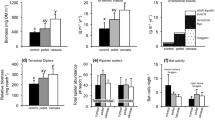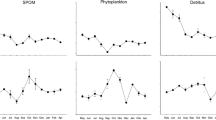Abstract
Decades of research have revealed the crucial roles of cross-system energy flows (spatial subsidies) in mediating trophic interactions in recipient systems. Food web theory predicts that the responses of subsidized consumers are a key to understanding the net impacts of spatial subsidies on in situ prey/resources of recipient systems. However, less is known about the factors triggering the cascading biotic interactions across coupled ecosystems. Here, we quantify how riverine productivity (donor system) mediates terrestrial food web interactions through spatial subsidies to simplified gravel bar communities. Our comparative study in Japan indicated that higher algal biomass in aquatic systems led to increased supplies of emerging aquatic insects, which were associated with greater densities of terrestrial consumers (Carabid beetles) and enhanced consumption rates of supplemental in situ prey on gravel bars. Our results highlight the potential of donor productivity to drive cascading biotic interactions across coupled ecosystems. Because cross-system energy flows should originate, at least in part, from primary producers of donor systems, our fundamental finding may form the basis of future studies exploring the driving factors of cross-system trophic interactions.



Similar content being viewed by others
References
Baxter CV, Fausch KD, Saunders WC. 2005. Tangled webs: reciprocal flows of invertebrate prey link streams and riparian zones. Freshw Biol 50:201–20.
Burdon FJ, Harding JS. 2008. The linkage between riparian predators and aquatic insects across a stream-resource spectrum. Freshw Biol 53:330–46.
Collins SM, Kohler TJ, Thomas SA, Fetzer WW, Flecker AS. 2016. The importance of terrestrial subsidies in stream food webs varies along a stream size gradient. Oikos 125:674–85.
Denwood MJ. 2016. runjags: an R package providing interface utilities, model templates, parallel computing methods and additional distributions for MCMC models in JAGS. J Stat Softw 71:1–25.
Doi H. 2009. Spatial patterns of autochthonous and allochthonous resources in aquatic food webs. Popul Ecol 51:57–64.
Gelman A, Hill J. 2007. Data analysis using regression and multilevel/hierarchical models. New York: Cambridge University Press.
Giery ST, Lemoine NP, Hammerschlag-Peyer CM, Abbey-Lee RN, Layman CA. 2013. Bidirectional trophic linkages couple canopy and understorey food webs. Funct Ecol 27:1436–41.
Henschel JR, Mahsberg D, Stumpf H. 2001. Allochthonous aquatic insects increase predation and decrease herbivory in river shore food webs. Oikos 93:429–38.
Lefcheck JS. 2016. piecewiseSEM: piecewise structural equation modelling in R for ecology, evolution, and systematics. Methods Ecol Evolut 7:573–9.
Leroux SJ, Loreau M. 2008. Subsidy hypothesis and strength of trophic cascades across ecosystems. Ecol Lett 11:1147–56.
Lunn D, Jackson C, Best N, Thomas A, Spiegelhalter D. 2012. The BUGS book: a practical introduction to Bayesian analysis. Boca Raton: CRC Press.
Marczak LB, Thompson RM, Richardson JS. 2007. Meta-analysis: trophic level, habitat, and productivity shape the food web effects of resource subsidies. Ecology 88:140–8.
Nakagawa S, Schielzeth H. 2013. A general and simple method for obtaining R2 from generalized linear mixed-effects models. Methods Ecol Evolut 4:133–42.
Nakano S, Miyasaka H, Kuhara N. 1999. Terrestrial-aquatic linkages: riparian arthropod inputs alter trophic cascades in a stream food web. Ecology 80:2435–41.
Nakano S, Murakami M. 2001. Reciprocal subsidies: dynamic interdependence between terrestrial and aquatic food webs. Proc Natl Acad Sci USA 98:166–70.
Paetzold A, Schubert CJ, Tockner K. 2005. Aquatic terrestrial linkages along a braided-river: riparian arthropods feeding on aquatic insects. Ecosystems 8:748–59.
Polis GA, Anderson WB, Holt RD. 1997. Toward an integration of landscape and food web ecology: the dynamics of spatially subsidized food webs. Annu Rev Ecol Syst 28:289–316.
Rahel FJ, Hubert WA. 1991. Fish assemblages and habitat gradients in a Rocky Mountain-Great Plains stream: biotic zonation and additive patterns of community change. Trans Am Fishe Soc 120:319–32.
R Core Team. 2016. R: a language and environment for statistical computing. Vienna: R Foundation for Statistical Computing. https://www.R-project.org/.
Ruff CP, Schindler DE, Armstrong JB, Bentley KT, Brooks GT, Holtgrieve GW, McGlauflin MT, Torgersen CE, Seeb JE. 2011. Temperature-associated population diversity in salmon confers benefits to mobile consumers. Ecology 92:2073–84.
Sabo J, Power M. 2002. River-watershed exchange: effects of riverine subsidies on riparian lizards and their terrestrial prey. Ecology 83:1860–9.
Sato T, Egusa T, Fukushima K, Oda T, Ohte N, Tokuchi N, Watanabe K, Kanaiwa M, Murakami I, Lafferty KD. 2012. Nematomorph parasites indirectly alter the food web and ecosystem function of streams through behavioural manipulation of their cricket hosts. Ecol Lett 15:786–93.
Shimazaki A, Miyashita T. 2005. Variable dependence on detrital and grazing food webs by generalist predators: aerial insects and web spiders. Ecography 28:485–94.
Spiller DA, Piovia-Scott J, Wright AN, Yang LH, Takimoto G, Schoener TW, Iwata T. 2010. Marine subsidies have multiple effects on coastal food webs. Ecology 91:1424–34.
Takagi S, Miyashita T. 2015. Time-scale dependency of host plant biomass-and trait-mediated indirect effects of deer herbivory on a swallowtail butterfly. J Anim Ecol 84:1657–65.
Takimoto G, Iwata T, Murakami M. 2008. Timescale hierarchy determines the indirect effects of fluctuating subsidy inputs on in situ resources. Am Nat 173:200–11.
Terui A, Akasaka T, Negishi JN, Uemura F, Nakamura F. 2017. Species-specific use of allochthonous resources by ground beetles (Carabidae) at a river–land interface. Ecol Res 32:27–35.
Terui A, Miyazaki Y. 2016. Three ecological factors influencing riverine fish diversity in the Shubuto River system, Japan: habitat capacity, habitat heterogeneity and immigration. Limnology 17:143–9.
Terui A, Miyazaki Y. 2017. Combined effects of immigration potential and habitat quality on diadromous fishes. Limnology 18:121–9.
Acknowledgements
We are grateful to B. Nessa, H. Imai, T. Akasaka, A. Agui and student volunteers for their field/laboratory assistance. This study is partly supported by the research fund for the Ishikari and Tokachi Rivers provided by the Ministry of Land, Infrastructure, Transport, and Tourism of Japan.
Data accessibility
Data and JAGS code are available as online electronic supplementary material.
Author information
Authors and Affiliations
Corresponding author
Electronic supplementary material
Below is the link to the electronic supplementary material.
Rights and permissions
About this article
Cite this article
Terui, A., Negishi, J.N., Watanabe, N. et al. Stream Resource Gradients Drive Consumption Rates of Supplemental Prey in the Adjacent Riparian Zone. Ecosystems 21, 772–781 (2018). https://doi.org/10.1007/s10021-017-0183-3
Received:
Accepted:
Published:
Issue Date:
DOI: https://doi.org/10.1007/s10021-017-0183-3




